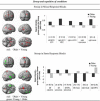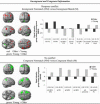Age-related reorganization of functional networks for successful conflict resolution: a combined functional and structural MRI study
- PMID: 20022675
- PMCID: PMC2888896
- DOI: 10.1016/j.neurobiolaging.2009.12.002
Age-related reorganization of functional networks for successful conflict resolution: a combined functional and structural MRI study
Abstract
Aging has readily observable effects on the ability to resolve conflict between competing stimulus attributes that are likely related to selective structural and functional brain changes. To identify age-related differences in neural circuits subserving conflict processing, we combined structural and functional MRI and a Stroop Match-to-Sample task involving perceptual cueing and repetition to modulate resources in healthy young and older adults. In our Stroop Match-to-Sample task, older adults handled conflict by activating a frontoparietal attention system more than young adults and engaged a visuomotor network more than young adults when processing repetitive conflict and when processing conflict following valid perceptual cueing. By contrast, young adults activated frontal regions more than older adults when processing conflict with perceptual cueing. These differential activation patterns were not correlated with regional gray matter volume despite smaller volumes in older than young adults. Given comparable performance in speed and accuracy of responding between both groups, these data suggest that successful aging is associated with functional reorganization of neural systems to accommodate functionally increasing task demands on perceptual and attentional operations.
Copyright © 2009 Elsevier Inc. All rights reserved.
Figures





Similar articles
-
Aging and response conflict solution: behavioural and functional connectivity changes.Brain Struct Funct. 2015;220(3):1739-57. doi: 10.1007/s00429-014-0758-0. Epub 2014 Apr 10. Brain Struct Funct. 2015. PMID: 24718622 Free PMC article.
-
A multivariate analysis of age-related differences in functional networks supporting conflict resolution.Neuroimage. 2014 Feb 1;86:150-63. doi: 10.1016/j.neuroimage.2013.08.002. Epub 2013 Aug 9. Neuroimage. 2014. PMID: 23939020
-
Connectome-based models predict attentional control in aging adults.Neuroimage. 2019 Feb 1;186:1-13. doi: 10.1016/j.neuroimage.2018.10.074. Epub 2018 Oct 28. Neuroimage. 2019. PMID: 30394324
-
Examining a supramodal network for conflict processing: a systematic review and novel functional magnetic resonance imaging data for related visual and auditory stroop tasks.J Cogn Neurosci. 2008 Jun;20(6):1063-78. doi: 10.1162/jocn.2008.20074. J Cogn Neurosci. 2008. PMID: 18211237
-
Putting age-related task activation into large-scale brain networks: A meta-analysis of 114 fMRI studies on healthy aging.Neurosci Biobehav Rev. 2015 Oct;57:156-74. doi: 10.1016/j.neubiorev.2015.08.013. Epub 2015 Aug 28. Neurosci Biobehav Rev. 2015. PMID: 26318367 Review.
Cited by
-
The neural correlates of priming emotion and reward systems for conflict processing in alcoholics.Brain Imaging Behav. 2017 Dec;11(6):1751-1768. doi: 10.1007/s11682-016-9651-1. Brain Imaging Behav. 2017. PMID: 27815773 Free PMC article.
-
Reduced monoaminergic nuclei MRI signal detectable in pre-symptomatic older adults with future memory decline.Sci Rep. 2020 Oct 30;10(1):18707. doi: 10.1038/s41598-020-71368-1. Sci Rep. 2020. PMID: 33127923 Free PMC article.
-
Growth trajectories of cognitive and motor control in adolescence: How much is development and how much is practice?Neuropsychology. 2022 Jan;36(1):44-54. doi: 10.1037/neu0000771. Epub 2021 Nov 22. Neuropsychology. 2022. PMID: 34807641 Free PMC article.
-
Effects of age, sex, and puberty on neural efficiency of cognitive and motor control in adolescents.Brain Imaging Behav. 2020 Aug;14(4):1089-1107. doi: 10.1007/s11682-019-00075-x. Brain Imaging Behav. 2020. PMID: 30903550 Free PMC article.
-
Aging with HIV-1 Infection: Motor Functions, Cognition, and Attention--A Comparison with Parkinson's Disease.Neuropsychol Rev. 2015 Dec;25(4):424-38. doi: 10.1007/s11065-015-9305-x. Epub 2015 Nov 17. Neuropsychol Rev. 2015. PMID: 26577508 Free PMC article. Review.
References
-
- Ashburner J, Friston KJ. Voxel-based morphometry--the methods. Neuroimage. 2000;11:805–821. - PubMed
-
- Bach M. The Freiburg Visual Acuity test--automatic measurement of visual acuity. Optom Vis Sci. 1996;73:49–53. - PubMed
-
- Botvinick MM. Conflict monitoring and decision making: reconciling two perspectives on anterior cingulate function. Cogn Affect Behav Neurosci. 2007;7:356–366. - PubMed
-
- Braver TS, Barch DM. A theory of cognitive control, aging cognition, and neuromodulation. Neurosci Biobehav Rev. 2002;26:809–817. - PubMed
-
- Brett M, Anton J-L, Valabregue R, Poline J-B. Region of interest analysis using an SPM toolbox [abstract]. Presented at the 8th International Conference on Functional Mapping of the Human Brain; Sendai, Japan. June 2–6; 2002. Available on CD-ROM in NeuroImage 16, No 2.
Publication types
MeSH terms
Grants and funding
- R01 AA005965/AA/NIAAA NIH HHS/United States
- AA017168/AA/NIAAA NIH HHS/United States
- AA005965/AA/NIAAA NIH HHS/United States
- AG017919/AG/NIA NIH HHS/United States
- K05 AA017168/AA/NIAAA NIH HHS/United States
- R01 AG017919/AG/NIA NIH HHS/United States
- R01 AA010723/AA/NIAAA NIH HHS/United States
- R37 AA005965/AA/NIAAA NIH HHS/United States
- R37 AA010723/AA/NIAAA NIH HHS/United States
- R01 AA018022/AA/NIAAA NIH HHS/United States
- AA010723/AA/NIAAA NIH HHS/United States
- R01 AA017923/AA/NIAAA NIH HHS/United States
LinkOut - more resources
Full Text Sources
Medical

